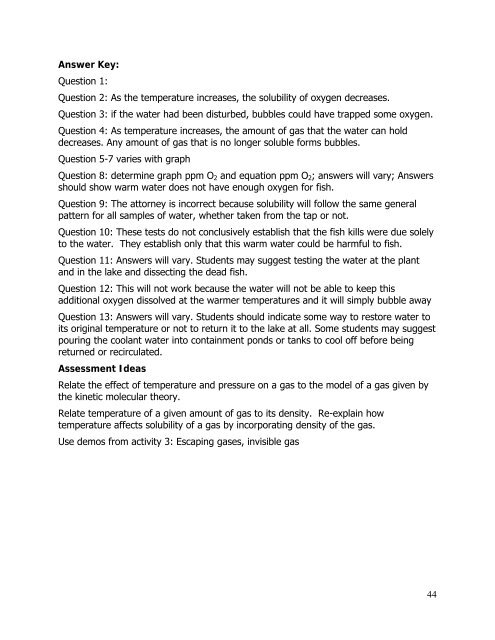Kinetic Molecular Theory Gas Laws - Oakland Schools
Kinetic Molecular Theory Gas Laws - Oakland Schools
Kinetic Molecular Theory Gas Laws - Oakland Schools
Create successful ePaper yourself
Turn your PDF publications into a flip-book with our unique Google optimized e-Paper software.
Answer Key:<br />
Question 1:<br />
Question 2: As the temperature increases, the solubility of oxygen decreases.<br />
Question 3: if the water had been disturbed, bubbles could have trapped some oxygen.<br />
Question 4: As temperature increases, the amount of gas that the water can hold<br />
decreases. Any amount of gas that is no longer soluble forms bubbles.<br />
Question 5-7 varies with graph<br />
Question 8: determine graph ppm O 2 and equation ppm O 2 ; answers will vary; Answers<br />
should show warm water does not have enough oxygen for fish.<br />
Question 9: The attorney is incorrect because solubility will follow the same general<br />
pattern for all samples of water, whether taken from the tap or not.<br />
Question 10: These tests do not conclusively establish that the fish kills were due solely<br />
to the water. They establish only that this warm water could be harmful to fish.<br />
Question 11: Answers will vary. Students may suggest testing the water at the plant<br />
and in the lake and dissecting the dead fish.<br />
Question 12: This will not work because the water will not be able to keep this<br />
additional oxygen dissolved at the warmer temperatures and it will simply bubble away<br />
Question 13: Answers will vary. Students should indicate some way to restore water to<br />
its original temperature or not to return it to the lake at all. Some students may suggest<br />
pouring the coolant water into containment ponds or tanks to cool off before being<br />
returned or recirculated.<br />
Assessment Ideas<br />
Relate the effect of temperature and pressure on a gas to the model of a gas given by<br />
the kinetic molecular theory.<br />
Relate temperature of a given amount of gas to its density. Re-explain how<br />
temperature affects solubility of a gas by incorporating density of the gas.<br />
Use demos from activity 3: Escaping gases, invisible gas<br />
44
















